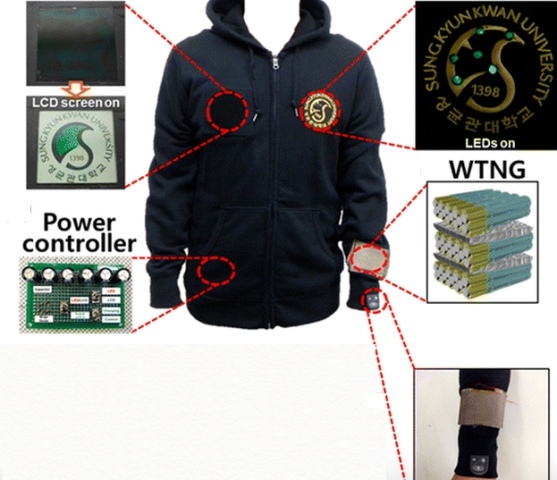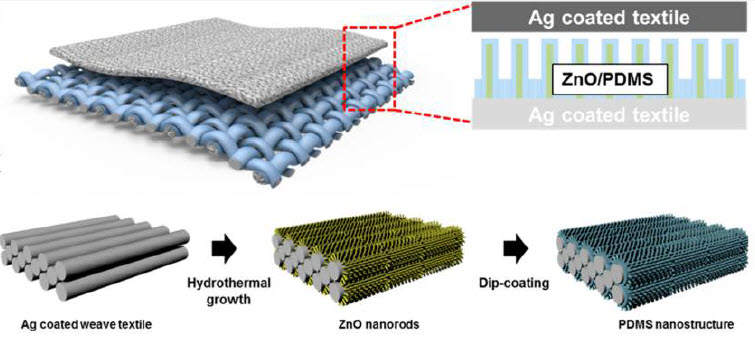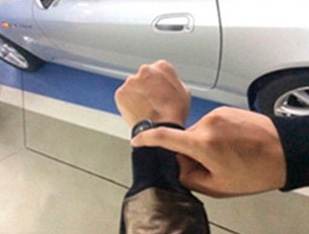This energy-generating cloth could replace batteries in wearable devices
March 6, 2015

Self-poweredLEDs, an LCD, and a keyless vehicle entry system are shown here embedded in a “self-powered smart suit” using the new WTNG cloth-based material (credit: Wanchul Seung et al./ACS Nano)
Scientists at Sungkyunkwan University in Korea and University of Wollongong in Australia report in the journal ACS Nano the first durable, flexible cloth that can harness human motion to generate energy, allowing for self-powered smart clothes.
The new technology avoids the need for batteries — a current limitation in wearable electronics.
The new textile can also charge batteries or supercapacitors without an external power source, making new applications possible, such as health care monitoring and batteryless personal electronics.
The cloth is based on triboelectric nanogenerators (TNGs). TNGs use two materials with different “triboelectric” polarities.
In a manner analogous to static electricity, when the two materials are contacted or rubbed together, then separated, electrons are generated and can flow through a connected device.
TNG devices are usually constructed on plastic materials; it’s been difficult to make them wearable.

Schematic illustration of the WTNG showing the fabrication process of the two active layers — silver (Ag) coated textile and zinc oxide/polydimethylsiloxane (PDMS) nanostructure — to generate elecrticity (credit: Wanchul Seung et al./ACS Nano)
So the researchers developed a new method of incorporating TNGs into cloth that allows it to be chemically and physically durable, using a silverized cloth material with nanorods and a silicon-based organic material embedded in four layers of cloth. They were able to generate a high output voltage (up to 120V) with an output current of 65 microamperes.
In tests, they found that the WTNGs (wearable TNGs) were able to power light-emitting diodes, a liquid crystal display, and a vehicle’s keyless entry remote, and worked for more than 12,000 cycles.

Operation of a remote-controlled keyless vehicle entry system using a commercial capacitor (1200 μF) charged only by the WTNG without any help from an external charging source (credit: Wanchul Seung et al./ACS Nano)
Abstract of Nanopatterned Textile-Based Wearable Triboelectric Nanogenerator
Here we report a fully flexible, foldable nanopatterned wearable triboelectric nanogenerator (WTNG) with high power-generating performance and mechanical robustness. Both a silver (Ag)-coated textile and polydimethylsiloxane (PDMS) nanopatterns based on ZnO nanorod arrays on a Ag-coated textile template were used as active triboelectric materials. A high output voltage and current of about 120 V and 65 μA, respectively, were observed from a nanopatterned PDMS-based WTNG, while an output voltage and current of 30 V and 20 μA were obtained by the non-nanopatterned flat PDMS-based WTNG under the same compressive force of 10 kgf. Furthermore, very high voltage and current outputs with an average value of 170 V and 120 μA, respectively, were obtained from a four-layer-stacked WTNG under the same compressive force. Notably it was found there are no significant differences in the output voltages measured from the multilayer-stacked WTNG over 12 000 cycles, confirming the excellent mechanical durability of WTNGs. Finally, we successfully demonstrated the self-powered operation of light-emitting diodes, a liquid crystal display, and a keyless vehicle entry system only with the output power of our WTNG without any help of external power sources.